What I learnt from my bike crash in Malana!
“Oh God no! I won’t be able to ride anymore! My life is over! Feels like I’ve broken my back!” ☹ This was the first thought that came to my mind when I flew off my 350cc Bullet right onto the road, beside a deep gorge, and landed on my butt!
Thankfully, my precious head was protected by a strong helmet. This was probably the first time in my life that I understood the importance of helmets. Until then, my helmet had simply been a heavy nuisance to carry around!


Well, within minutes I was up on my feet, and it didn't hurt as much as I’d anticipated. My riding partner had cautioned me earlier: “If you ever fall as I ride up just push yourself away from the bike, so you don't come under the 200 kg giant’s silencer pipe.” The right information at just about the right time, helped.
We went through all this pain to reach one of the most beautiful destinations in Himachal Pradesh: Malana. This place is located at an altitude of 8,700 feet, on a remote narrow plateau with a wild deep valley on one side, close to the river Parvati in the Kullu valley of Himachal Pradesh, with mind-blowing views. As crazy as biking to such a place during the monsoon might sound, it was a real adrenaline rush.
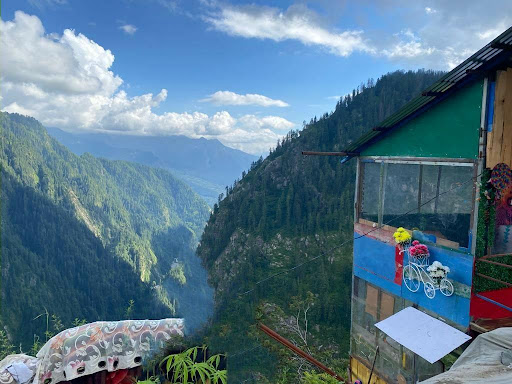

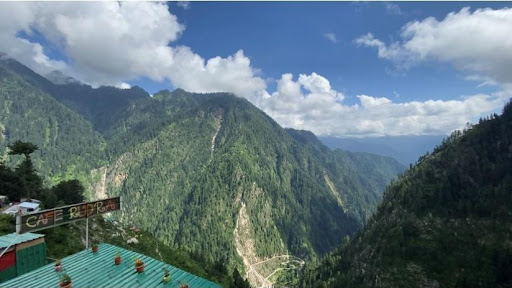

My crazy journey started at a cute little hamlet named Kasol. The beginning of the journey was so comfortable: breezy roads, a little rain, and beautiful landscapes ahead of us. You can’t help but start thinking about the most romantic Bollywood movies! I was feeling fortunate, as I thought I’d be able to reach my dream destination relatively easily. This was until we reached the Malana Hydro project office, where we realized that the landscape had suddenly changed.
The beautiful and sober road gave way to rocky white roads, and the first thing that came to my mind was, had I taken on too much risk? Should we leave our bikes behind and start walking from that point on? Reality hit hard when we asked the officers at the project office and they said the village was at least 11 km uphill! All four of us stared at each other, none of us were physically prepared for that steep hike (despite all the workout sessions in the previous few months!).
So we decided to start riding slowly and cautiously. All my thoughts of video-recording the ride flew into the wind as I was busy balancing myself with all the extra weight we were carrying, so my fellow rider wasn’t overly stressed. The surprises just kept on coming: soon, we faced the next roadblock, a huge landslide that blocked 80% of the road.
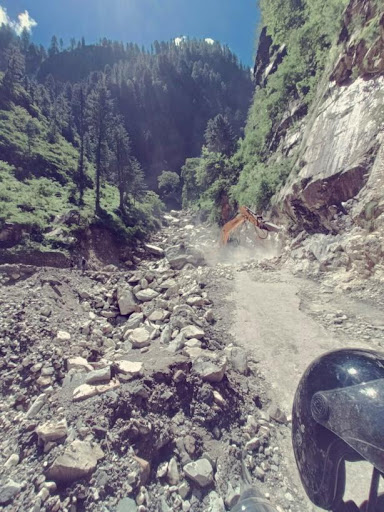

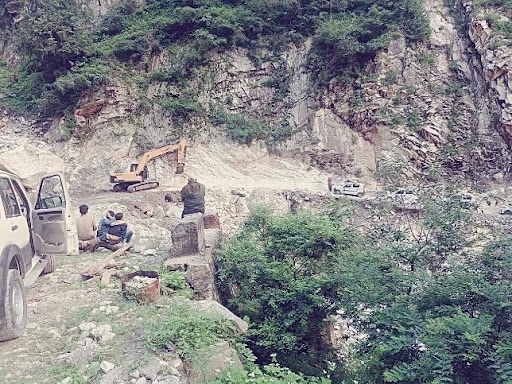

After a 90-minute-long picturesque ride through the mountains and narrow roads, getting stuck due to landslides twice and the fall from the bike (which could’ve turned out a lot worse), we finally reached our destination. We took a key decision after reaching the village gate, before hiking through the rest of the village on foot. We set aside our bikes and got the guys who rented them to us to pick them up and take them back (pleading and some extra cash did the trick). It was then time to go on the 90-minute trek to our final goal: the breathtaking views and the cozy beautiful cafes at the top of the village.
The hike along the Malana trail merits a whole different article. But this real-life experience of riding along highly dangerous roads to reach my goal made me think about something fundamental I consider, as I invest: Risk Profiling.
Wait. What?
Risk profiling has always been one of my favorite topics. Perhaps that’s because of my own psychological make-up, my belief that if I follow the process the right way, all will be right. Or might there be more to it?
The fundamentals of risk profiling tell us we have to evaluate three key elements to understand ourselves better, before we invest.
1. Risk tolerance
2. Risk capacity
3. Required risk
Risk tolerance is how much risk you’re willing to accept based on the degree of uncertainty that you might be able to handle. This is a more ‘emotional’ factor and varies with age, temperament, experience etc.
Risk capacity is how much risk you’re able to accept. This is less to do with emotions, more to do with your current financial situation and financial goals and varies with your income, number of dependents, owned assets (or liabilities) etc.
Required risk is purely mathematical- it relates to what we aspire to get and how much risk you need to take, to get there. For example, if you want to get to Rs 1 crore in 5 years but have only Rs 1 lakh today, the math will determine the instrument you need to find, which will make your money grow 100X in 5 years. By the way, if you find this, tell me also please.
Now you might wonder, is it even possible to know how much risk we can take without ever having done it in real life? Probably not. We will know how heavy our fears weigh only when we face them. So, it's perfectly all right to make some mistakes early on when you start investing your hard-earned money only to discover your fear threshold.
You might also want to take the help of psychometric tools to gauge your risk-profile.
I must plug this awesome new tool that I show to investors I meet during my Financial Wellness Sessions: A Personalized Recommendation Tool which can help you easily identify your risk-taking style (it goes one step further and gives you a personalized asset-allocation recommendation based on your responses). Thousands have already tried it. Give it a shot below:
I recommend you must also meet and have a detailed conversation with an expert like a MF Distributor, who will probe deeper to help you deep-dive and recognize what’s right for you, based on the situations you may have faced and your responses to them.
Had I not become a pillion rider on those deadly roads, I’d never have learned that I could deal with my fear of heights and unstable roads. Similarly, when it comes to money, many of us might want to continue being in our comfort zone, thinking that the stock market isn’t for us: an FD is so much more comfortable! Human beings often love the status quo. But it may be a good idea to face our fears first and then decide how much risk we can tolerate.
When you think about this wide range of factors, such as your fears, your desires, your age, dependents, number of liabilities, what you earn, what you save etc, you also realize one key factor. Not everything is in your control, but some of these factors can certainly be addressed. Can one not limit borrowing? Can you not be more rational about saving money? It can be done, with just a little bit of planning.
I’m reminded of the fact that when renting the right bikes for the road trip, we discussed a lot about which one would be less expensive and more fuel-efficient. But what ultimately ended up mattering the most to us as a collective unit was safety. Hiring an expensive bike was a natural choice that led us to cut back on other costs like staying and partying.
There’s a simple lesson here: one can only measure risk capacity accurately by being clear and rational about the ultimate use of the money being invested.
-png.png)
-png.png)
Another important factor about risk profiling could be that our goals are often those we jointly have, with our family members or life partners. That will call for some adjustments to each other’s financial positions and potential compromises, so that we can reach our goals smoothly without giving any undue stress to us. Less friction will also mean you’ll be able to think straight when problems arise. So for couples in particular, it’s important that both partners take part in financial decisions, that they are aware of each other’s positions and feel well-prepared for contingencies.
It also needs to be acknowledged that the goal we wanted to achieve (riding through the most beautiful landscapes of Malana) was a high-risk goal: it was dangerously intriguing. But when our goals are clear and achievable in principle, we can find it in ourselves to bend the way we think about fear and make the right choices to make things work for us.
And voilà: before long, we find ourselves at our destination!
Heed these words, O investor!
Truth be told, these ideas are relevant not just to risk profiling as you manage your hard-earned money, but also when it comes to all the life goals you’re passionately chasing.
Risk profiling is not exactly a one-time evaluation exercise: as life situations change, so does our risk profile. It may thus be a good idea to revisit and re-evaluate it from time to time, to ensure you’re on the right track.
A final message: The more money you make, the more you can travel and learn from those incredible experiences. It is a beautiful and joyful virtuous cycle. Those who really love travel will agree…
कैसा ये इस्क है
अजब सा रिस्क है 😊
-jpg.jpeg)
-jpg.jpeg)
About the author
Sumana Datta leads the Financial Wellness Program for DSP, aiming to create thousands of better investors across India through her workshops. A true Sagittarian, she is a free spirit who loves to wander, a fitness freak and a dedicated plant parent. She enjoys interacting with people and loves public speaking and conversations. Being an avid traveler, she believes “The journey of a thousand miles begins with a single step”.Disclaimer
This note is for information purposes only. In this material DSP Asset Managers Pvt Ltd (the AMC) has used information that is publicly available and is believed to be from reliable sources. While utmost care has been exercised, the author or the AMC does not warrant the completeness or accuracy of the information and disclaims all liabilities, losses and damages arising out of the use of this information. Readers, before acting on any information herein should make their own investigation & seek appropriate professional advice. Any sector(s)/ stock(s)/ issuer(s) mentioned do not constitute any recommendation and the AMC may or may not have any future position in these. All opinions/ figures/ charts/ graphs are as on date of publishing (or as at mentioned date) and are subject to change without notice. Any logos used may be trademarks™ or registered® trademarks of their respective holders, our usage does not imply any affiliation with or endorsement by them.
Past performance may or may not be sustained in the future and should not be used as a basis for comparison with other investments.
Mutual fund investments are subject to market risks, read all scheme related documents carefully.
.png)
-png.png)
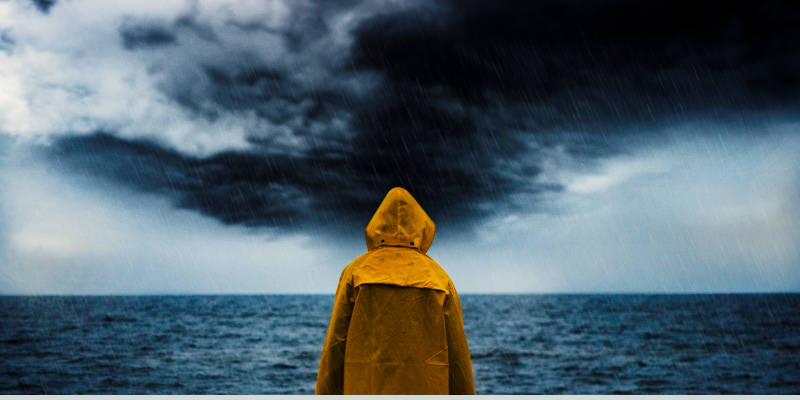





Leave a comment